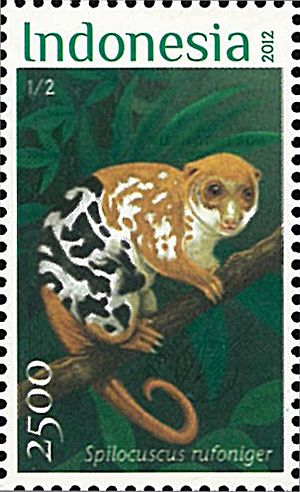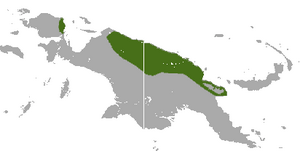Black-spotted cuscus facts for kids
Quick facts for kids Black-spotted cuscus |
|
|---|---|
 |
|
| Conservation status | |
| Scientific classification | |
| Genus: |
Spilocuscus
|
| Species: |
rufoniger
|
 |
|
| Black-spotted cuscus range | |
The black-spotted cuscus (Spilocuscus rufoniger) is a type of marsupial from the Phalangeridae family. Marsupials are animals that carry their young in a pouch. This cuscus is one of the biggest animals in its family, with only the bear cuscus being larger.
These colorful animals live in the forests of northern New Guinea. Sadly, they are in danger because of hunting and losing their homes. Because of this, the IUCN says they are Critically Endangered. This means they are at a very high risk of disappearing forever.
Contents
About the Black-Spotted Cuscus
Cuscuses are part of a group of animals called Phalangerids. These animals first appeared in Australia's rainforests a long, long time ago. Over millions of years, cuscuses changed and became different from other Phalangerids. Scientists believe that cuscuses moved to the New Guinea area, while their relatives, the possums, stayed in Australia.
The black-spotted cuscus has some special features. For example, it has a unique jaw muscle structure. It also has large spaces in its forehead bones. These features help scientists know that it belongs to the marsupial family Phalangeridae.
Where They Live
The black-spotted cuscus lives only on the island of New Guinea. You can find them across northern New Guinea. They are often seen in places like Sattelberg in the Morobe Province of Papua New Guinea.
These cuscuses prefer to live in untouched, tropical forests and low-lying areas with thick bushes. They usually stay below 1200 meters (about 4000 feet) in elevation. They can also be found in secondary forests, which are forests that have grown back after being cut down.
What They Look Like
Black-spotted cuscuses are some of the biggest animals in the Phalangeridae family. Only the bear cuscus is larger. An adult black-spotted cuscus usually weighs about 6 to 7 kilograms (13 to 15 pounds). They are typically around 120 centimeters (47 inches) long. Their head and body are about 70 centimeters (28 inches), and their tail is about 50 centimeters (20 inches).
Both male and female adult cuscuses have thick, woolly fur that is red and black. However, females are usually bigger. Females have a dark, saddle-like pattern on their fur. Males have more spotty patterns. Young cuscuses change colors as they grow up. The underside of their bodies is yellow and white. Female cuscuses have four milk glands and special pouches for their babies. These pouches open towards the front.
Black-spotted cuscuses have round heads with short, pointed snouts. Their forehead bones are rounded, giving them a bulging forehead. They have large sinuses in their heads. Their eyes are big with pupils that split vertically. This helps them see well at night, as they are active at night. They have fur inside their ears, which makes their ears almost invisible. You can tell black-spotted cuscuses apart from other cuscuses by their teeth. They have low crowns and small premolars in their upper jaw.
They have curved front claws that are sharp, which helps them climb. The first two fingers on their front paws can move opposite to the other three. This helps them grip branches. Their back feet are also good for grasping. Their big toe can move opposite to the others and has no claw. Their second and third toes are joined together.
Black-spotted cuscuses mainly use their tails to grab things. The tip of their tail has no fur. The underside of their tail has rough patches, which makes it easier for them to pick up items like food.
Behavior and Lifestyle
Black-spotted cuscuses are warm-blooded animals. They spend most of their time in trees and only come down to the ground sometimes. Since they are nocturnal, they sleep curled up on high branches during the day. They are generally slow-moving and prefer to live alone. They find food and build nests by themselves. When two cuscuses meet, they often act aggressively towards each other. There are no known predators that hunt black-spotted cuscuses in the trees where they live.
Reproduction and Life Cycle
Not much is known about how black-spotted cuscuses find mates. They usually court each other on tree branches. Black-spotted cuscuses have babies through sexual reproduction. They are viviparous, meaning the mother gives birth to live young.
Parental Care
The mother has a pouch where she nurses and protects her helpless altricial babies. We don't know much more about how black-spotted cuscus parents care for their young.
What They Eat
Scientists don't know a lot about what this species eats. They are thought to be omnivores, meaning they eat both plants and animals. They might eat small animals, as well as fruits, leaves, and nuts.
Population Status
The IUCN has changed the status of the black-spotted cuscus several times. From 1982 to 1990, it was listed as "Rare." Then it became "Vulnerable" in 1994, and "Endangered" in 1996. Since 2010, it has been classified as Critically Endangered. This means their numbers are dropping very quickly because of human activities.
As more people live in New Guinea, forests are being cleared for farms. For example, more people from Javan are moving to Papua New Guinea. This destroys the homes of the black-spotted cuscuses and causes their numbers to fall.
There are also plans for palm oil farms and logging in areas where black-spotted cuscuses live. International trade also affects the variety of life on Papua New Guinea. The country exports many goods, which can harm the species.
The biggest threat to the black-spotted cuscus is too much hunting. Because they are large, people often hunt them for their meat. Their thick, colorful fur is also used for capes and headwear. Since black-spotted cuscuses live in a limited area, they are easy targets for hunters.
Protecting the Black-Spotted Cuscus
Currently, there are no national parks in Papua New Guinea specifically to protect this species. However, to help with their critically endangered status, a special management area has been created in Papua New Guinea. There are also many areas in Indonesia where black-spotted cuscuses can live safely.
To further help these animals, rules about hunting need to be put in place. Also, people need to be taught about how important it is to protect these unique creatures.
See also
 In Spanish: Spilocuscus rufoniger para niños
In Spanish: Spilocuscus rufoniger para niños


